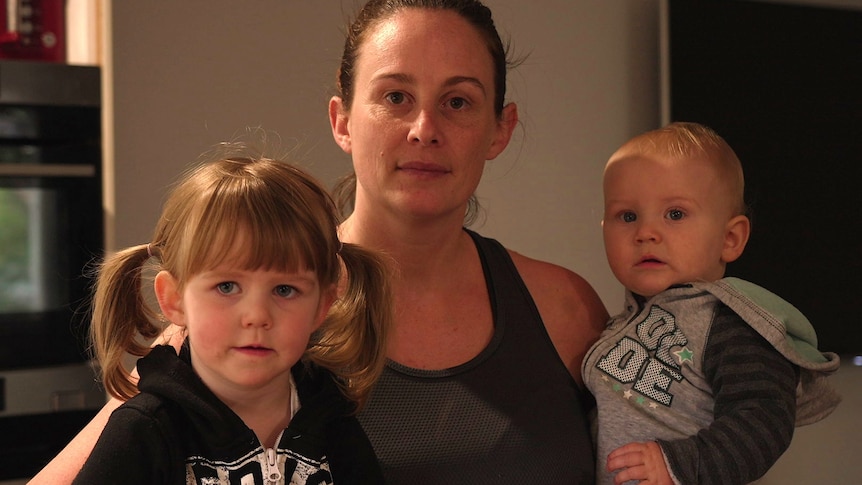More Australians are now experiencing mild to moderate food insecurity due to the cost and unavailability of fruit and vegetables leading to ill health and pressures on charities, experts warn.
Key points:
- Australia is experiencing mild to moderate food insecurity due to the rising costs of fruit and vegetables, an expert says
- One family says their grocery bill has more than doubled with fresh food difficult to afford
- There is concern poor nutrition could have a detrimental effect on the public health system
The skyrocketing cost of living has been particularly difficult for mum of three Jane Winters.
Her family of five, who live in Redcliffe, north of Brisbane, have seen their weekly grocery bill more than double from between $100 and $150 to nearly $300.
“We are going standard, home brand, whatever we can just to try and save some money because it’s a bit ridiculous,” she said.
A grocery list that was once full of fresh produce and healthy ingredients has now been replaced with cheaper alternatives and processed food.
“Fast food is fast becoming cheaper than healthy food which is awful,” Ms Winter said.
“It’s going to become a really big problem and I think childhood obesity is going to get so much bigger because of that.”
‘Unable to send kids to school with lunch’
Melissa Peters works in an affordable food shop west of Brisbane known as Restore, run by a not-for-profit organization Ipswich Assist.
She said the charity has seen a marked increase in families, some on dual incomes, seeking help to feed their families.
“Prior to this increase in the cost of living, we were seeing around maybe 30 to 40 people come through each week and now we’re cracking upwards of 100 people, 100 families coming through each week,” Ms Peters said.
“People tell us that they’re no longer able to afford just basic groceries, fruit and veggies, they’re unable to send their kids to school with lunches because the cost of living is just getting higher and higher each week.”
The store receives food from OzHarvest and Foodbank, as well as donations from mainstream supermarkets, with all items sold for $1 each.
“We’re seeing more and more families come through that have never needed to seek assistance before because they’ve never experienced any sort of financial hardship or crisis in the past,” she said.
“It’s a sense of vulnerability that they don’t want to have to show to the world… [but] we often remind them that seeking assistance is not weak.”
‘A big domino effect’
With the rising cost of food, fuel and rent showing no sign of abating, Ms Peters said the situation was only expected to worsen.
“At what point does it end? At what point does something happen that stops it from affecting every day Aussies?” she said.
“If people dig themselves into debt and get more and more into financial crisis, they have to then rely on more and more places to provide assistance.
“And those assistance places don’t have enough funding and it just becomes this big domino effect on people not being able to support themselves.”
Redcliffe woman Pru Burke has also opened a free community pantry with stacks of free, donated pantry items destined for Queenslanders doing it tough.
“I see the mums every day come and tell me their stories and it is heartbreaking,” she said.
“It’s those small drops in the ocean that are going to save them a lot more money in the end.
“If you’ve got the ability, try doing something like this. Open a food pantry, talk to members of your community and find ways to help each other.”
Fears of rising obesity, chronic illness
University of Southern Queensland food security expert Aletha Ward said Australia was now experiencing mild to moderate food insecurity due to a lack of fruit and vegetable consumption.
“The problem with mild to moderate food insecurity is that it drives obesity, so we are having food, it is just not the right type of food,” Dr Ward said.
“Most families would not purchase an iceberg lettuce for $10.”
She said fresh food was often replaced with cheap pasta, bread and processed food, sparking fears of long-term health impacts among the general population.
“Only about 5 per cent of Australians have five serves of vegetables per day and with the pressures of the increased cost of vegetables it is just making it that little bit worse,” she said.
“This is a long-term consequence, so within 10 years to 20 years we could see skyrocketing rates of chronic disease.
“Children often have the eating patterns of their parents and that is handed down, so if we are seeing families that can’t afford fruit and vegetables, cutting out that can have a trans-generational effect and impact.”
She warned poor nutrition among the community could also have a detrimental effect on the public health system and lead to increased hospitalization rates.
She said governments should implement a subsidy on fresh produce to make healthy foods more affordable.
.
